Keyword research for SEO: the ultimate guide

Keyword research is an essential part of your SEO strategy. It’s the first step in the SEO copywriting process. Before you create your site’s content, you should find out what search terms your audience uses. Their search terms are your keywords. You can start writing useful, high-quality, and findable content based on these keywords. In this post, we’ll take you through the steps involved in keyword research.
Are you looking for a guide to keyword research for ecommerce? You can find more information tailored to your needs in this post about keyword research for online stores.
What is keyword research?
Keyword research is a critical component of search engine optimization (SEO) that involves identifying the keywords your audience uses when searching for the products or services you offer. By understanding these search terms, you can develop a strategic list of keywords to target, ensuring that your content aligns with what potential customers are looking for.
This process requires delving into your audience’s language and analyzing search traffic volume data to uncover popular and relevant keywords. Without effective keyword research, you might find yourself using language that doesn’t resonate with your audience or competing with industry giants — a battle that can be hard to win.
Regularly updating your keyword strategy helps you create content that attracts high-quality traffic and stays current with search trends. Keyword research is an ongoing effort to keep your visibility and competitiveness in search results.
Why is keyword research important?
Proper keyword research is important because it clarifies what search terms your audience uses. At Yoast, we frequently encounter business owners who use one set of words to describe their products while their target audience uses a completely different set of words! As a result, potential customers can’t find those websites. In other words, there’s a mismatch.
To avoid this mismatch, you should do thorough keyword research. This research will ensure you use the same words as your target audience. In addition, you should also consider your audience’s search intent. This will help you figure out what exactly your audience is looking for. All left is for you to write high-quality content that answers your audience’s questions!
Originality versus findability
What about originality? Isn’t it better to stand out and use different keywords than your competitors? Let’s say you (or your marketing department) decide to give a product an uncommon name. This can be a wise marketing decision because people can remember your product more easily. For example, you might stand out more if you rent out vacation cottages instead of vacation homes.
But beware: very few people search for [vacation cottages]. So, if you optimize your text for cottages, you’ll probably rank well on that specific term. However, because your audience uses a different word, you won’t generate much traffic or reach many potential customers.
A video on keyword research
In this video, we’ll tell you more about keyword research and how it should be done. It’s part of our SEO for beginner’s course, available through our Yoast SEO Academy subscription:
Essential concepts of keyword research
Before jumping into keyword research, we’ll briefly explain some of its essential concepts.
Focus keyword or keyphrase
A focus keyword or keyphrase is the word or phrase you want a certain page on your site to be found in Google. You determine your set of focus keyphrases by doing keyword research. Yoast SEO uses these words to analyze your content and suggest improvements.
Long-tail keywords
Long-tail keywords are more specific and less commonly searched for than head keywords. They focus on a niche. The longer and more specific search terms are, the easier it is to rank for them. Why? Because there will be less competition.
However, long-tail keywords are still worth ranking for! Even though fewer people are searching for them, they might be more motivated to buy, subscribe, sign up, etc.
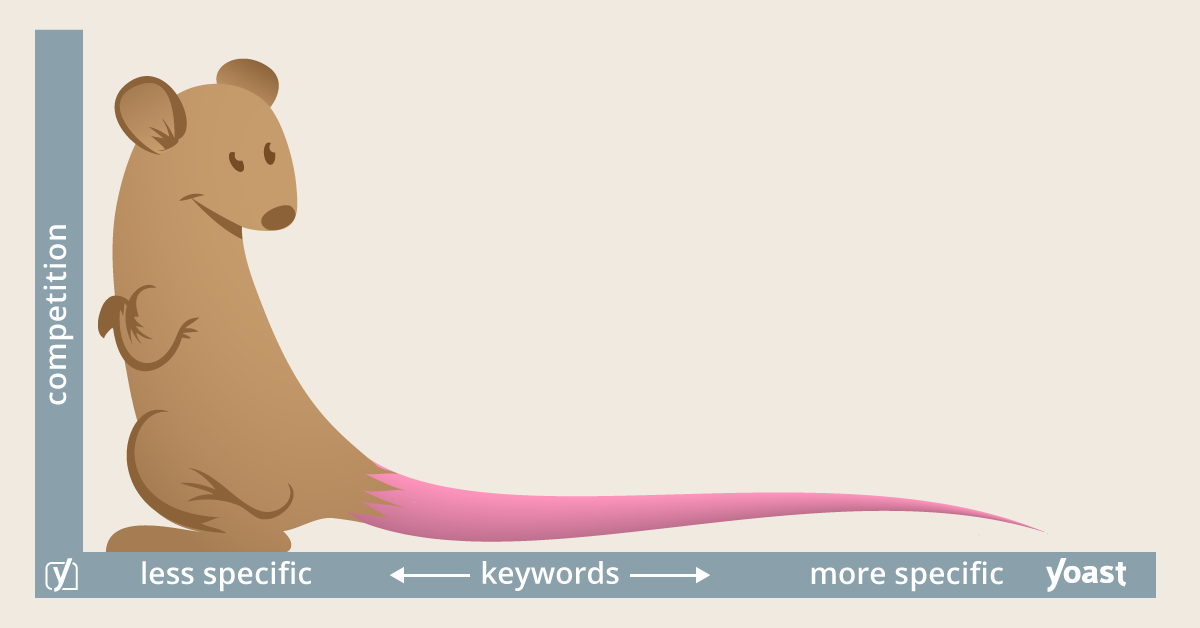
Keyword strategy
Your keyword strategy is about your decisions based on your keyword research. For instance, what content are you going to create first? Will you focus on the head or tail? How and where will you publish it? Will you create a piece of writing, a post or a product page, a video tutorial, or an infographic?
Search intent
Digging into search intent is key here: discover what a searcher wants or needs. You’re not just looking at keywords. You’re also looking at the underlying goals of what a searcher wants to know, do, or buy. Your content should provide a solution to the searcher’s “problem.” This is also known as content design.
Your audience and keyword research
Once you’ve determined what you have to offer, it’s time to consider your audience. How does your offering connect with the needs and goals of real people? Ultimately, SEO is all about making sure your users find what they’re looking for. However, there’s more to it than choosing the right keywords. Understanding your audience’s needs is essential for making great user-centric content, which is also an important part of good SEO. So, you must first find out which words your potential audience uses to find the information they want.
Let’s look at an example. At Yoast, we call our SEO training courses platform “Yoast SEO Academy.” So, at first, it might seem logical for us to optimize for the keyword [Yoast SEO Academy]. However, when we analyze traffic data, it turns out that our audience searches for [SEO training] or [SEO courses] way more often. So, it makes much more sense to optimize for that term instead.
Every company has its internal vocabulary, which often doesn’t match the vocabulary of its audience. Therefore, you should always select your keywords from your audience’s perspective. Using the integrated Semrush features in the Yoast SEO plugin, you can find keyword data and suggestions with just a few clicks. You can also try out the Yoast Suggest tool for more ideas.
What about your competition?
Lastly, you simply can’t devise a proper keyword research strategy without considering your competition. Often, websites optimize for terms they have no chance of ranking for. For instance, keywords with a high search volume can help a website connect with much bigger audiences, but you’ll only see positive results if you rank well. The search terms that deliver the highest traffic are highly competitive, so you must research your competition and assess the situation.
You could go overboard and thoroughly analyze all the competitors in your field, which can certainly be worthwhile. But let’s stick to the basics for now. It’s quite easy to get a general idea of your SEO competition. Just Google some search terms you would like to rank for, see which companies appear, and compare them with your site’s rank. How big are the companies you are competing with for those top three rankings? Would your company fit within these results? This is all quite easy to determine using only Google search results.
But be aware! You can’t just blindly trust the search results because Google tailors them to your personal search history, which means your site will come up higher for you than for others doing the same search. You can get around this by searching in incognito mode, although there’s even a local search component. If this is likely a problem for you, consider using a VPN to conceal your location or use Valentin.app to even choose a location yourself!
Using generative AI in keyword research
AI is changing SEO and, therefore, also keyword research, making it faster and more precise. Using AI, you can discover new keyword opportunities that might be missed with traditional methods. AI tools can quickly identify trends and find long-tail keywords that are less competitive and align well with what users are searching for.
Understanding what users intend with their searches is crucial, and AI helps with this by analyzing queries and suggesting how to tailor your content. It can classify keywords into intent groups like informational or transactional, helping you create content that meets user needs.
For content optimization, AI suggests ideas and improvements for your pages, ensuring they’re relevant and effective. AI tools provide insights on keyword placement and other on-page factors that can help improve your SEO.
To get started, consider using tools like Semrush or Ahrefs for AI-driven insights. These tools help you understand keyword trends and competition, giving you a strategic edge. Generative AI chatbots like OpenAI’s ChatGPT, Microsoft Copilot, and Google Gemini are useful tools for improving your keyword research process.
With AI’s help in your keyword research, you can better understand user intent and create high-quality, highly relevant content. This improves efficiency and makes sure that your SEO efforts impact your performance.
How to do keyword research in ten steps
There are ten crucial steps to follow when carrying out keyword research. We’ll guide you through the process and give you practical tips so you can conduct your keyword research:
- Think about your mission and determine your SEO goals
Before you start, think about your mission. Reflect on questions such as: What is the main goal of your business or organization? What makes it special? Who exactly are you trying to reach? And what promises do you make on your website? Take your time and literally write down your mission. Once you can answer these questions in detail, you’ll have taken the first and most important step in developing your keyword strategy.
What if you’re in a competitive market?
The market you’re in determines whether you’ll be able to rank high with your chosen keywords. Some markets are highly competitive, with large companies dominating the search results. Competing with these companies will be hard because they have huge budgets for marketing in general and SEO in particular.
If you’re launching into a competitive market, your best bet is to start small. Once you ‘own’ a small part of that niche and become a bigger name in your business area, you could try to level up and sell your cruises to a larger (more general) audience. Your mission will then become more general as well. The scope of your business mission should align with your SEO goals, too. Be realistic about what kind of rankings you can achieve with the size of your business, and focus on what will help you achieve your mission.
An example
Let’s say you sell cruises to Hawaii. You offer great facilities for children, which makes your cruises especially suitable for parents with younger kids. You will stand out if there are no other family-friendly cruises to Hawaii. This will make your service unique. So it would be smart to make this your mission, your niche — because this is what you have to offer your audience. - Make a list of keywords you think people might search for
The second step is creating a list of your keywords, preferably in a spreadsheet (like Google Sheets or Excel). With your mission in mind, try to get into the heads of your desired audience. What will these people be looking for? What search terms could they use while looking for your amazing service or product? Which of their “problems” does your product solve? Write down as many answers as possible. If your mission is clear, you will have a pretty clear image of your niche and unique selling points (the things that set your business apart from others). These are the search terms you want to be found for.
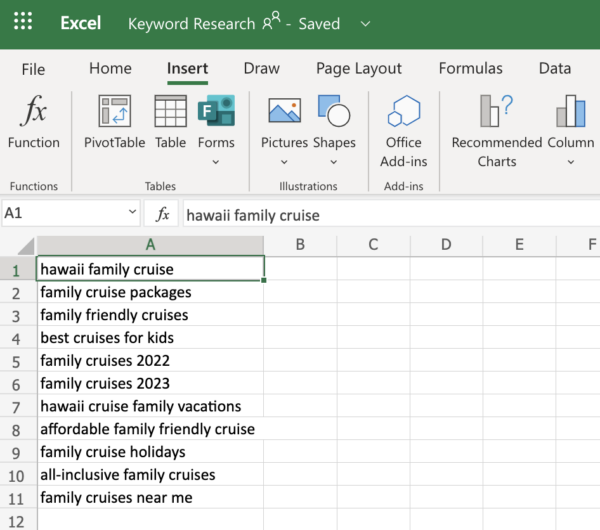
- Research the keywords you’ve come up with
After you’ve created your first list, it’s time to dive deeper into your keywords. Luckily, there are keyword research tools that make your keyword research easier.
One of the easiest tools to use is Google itself. Google the keywords you came up with and check what Google suggests while typing. Those are the questions people ask Google! You can also check the “related searches” and “people also ask” sections on Google’s results page. Also, look at our related keyphrases tool in Yoast SEO or Answer the Public. These tools will provide you with all kinds of variations of your keyphrases, synonyms, and related keyphrases. Check them out and add the relevant keyphrases to your list.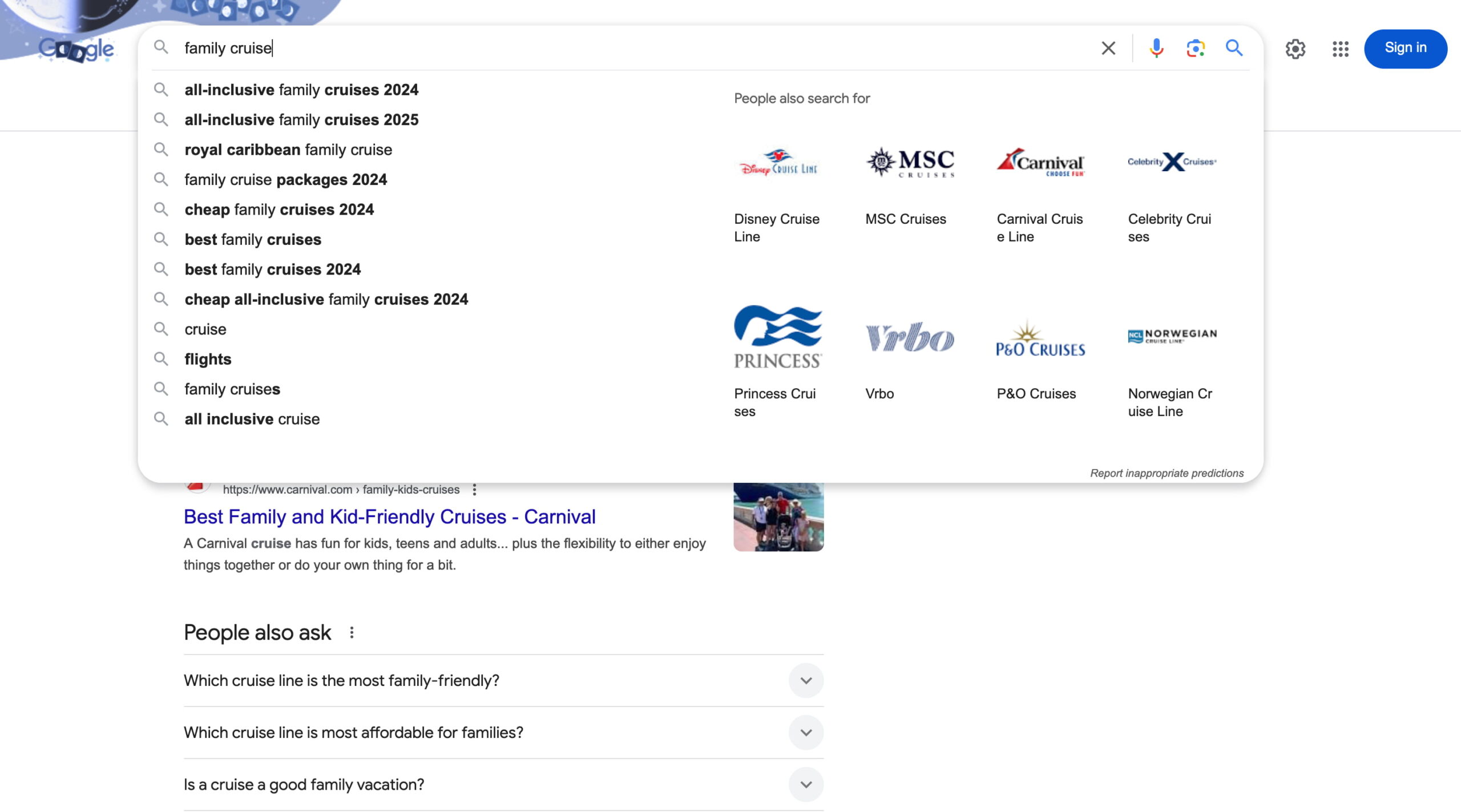
- Use your research to find long-tail variants of your keywords
When people start with keyword research, they focus on very popular “head” terms. Unfortunately, those head keywords are mostly taken by large businesses. Long-tail keywords, on the other hand, get less search traffic, but there’s less competition, too. Therefore, it’s easier for you to rank using those keywords. Moreover, long-tail keywords have a higher conversion value, focusing more on a specific product or topic.
An example
A long-tail keyword often is longer and more focused than a head term. If your head term is [puppy training], a long-tail keyword could be [positive puppy training for Labradoodles in Amsterdam]. The tools mentioned in step 3 will also help you find more long-tail keywords. You might also find some less-searched variants of your keywords, you can benefit from using these.
Use both!
Don’t forget to add the long-tail keywords and keyword variants to your spreadsheet. Put the head terms in the first column and add (multiple) columns for long-tail keywords and variants. This will also help you create a proper site structure later on. The more long-tail your search term is, the further down into your site structure its landing page belongs.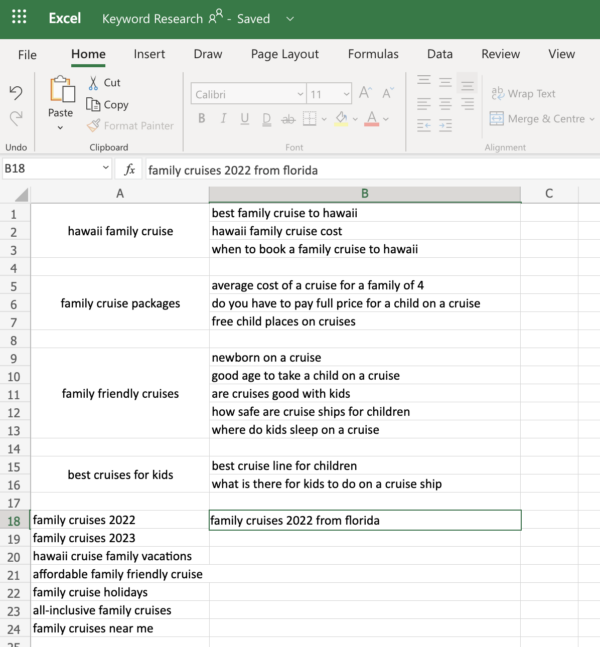
- Analyze your competition for those keywords
Whether you should go after long-tail keywords largely depends on your competition. If the competition in your niche is high, you’ll have a hard time ranking on competitive head terms. You can rank for more of your head terms with little competition. So, you’ll need to do some benchmarking for SEO.
Google the keywords that came out of your keyword research. Start with your most ‘head’ term. Check out the search engine result page (SERP). You’ll compete against these websites once you optimize your content for such a keyword. Take a closer look: Do you see professional websites? Company websites? Are you ‘equal’ to these companies? Does your website fit among these sites? Is your company of similar size, and does it have as much influence in your niche?
In the example below, it’s harder to rank when competing against sites with strong brand names, like Royal Caribbean and Carnival. If brands are known from TV or radio commercials, your chances to rank high will become even smaller. But it won’t hurt to take a look at their content. Is the content well-written and well-optimized? If your competition has poor content, you can outrank them!
Check Google Ads
You can also look at ads on Google. Are there any? If you have a Google Ads account, you can check the pay-per-click value of each search term using their Keyword Planner tool. Search terms with a high pay-per-click are usually harder to rank in organic results.
Make notes!
Make notes in your spreadsheet about your findings for the keywords you’ve investigated! You can use colors like red, yellow, and green to mark which keywords are more or less competitive if you find that easier than writing notes.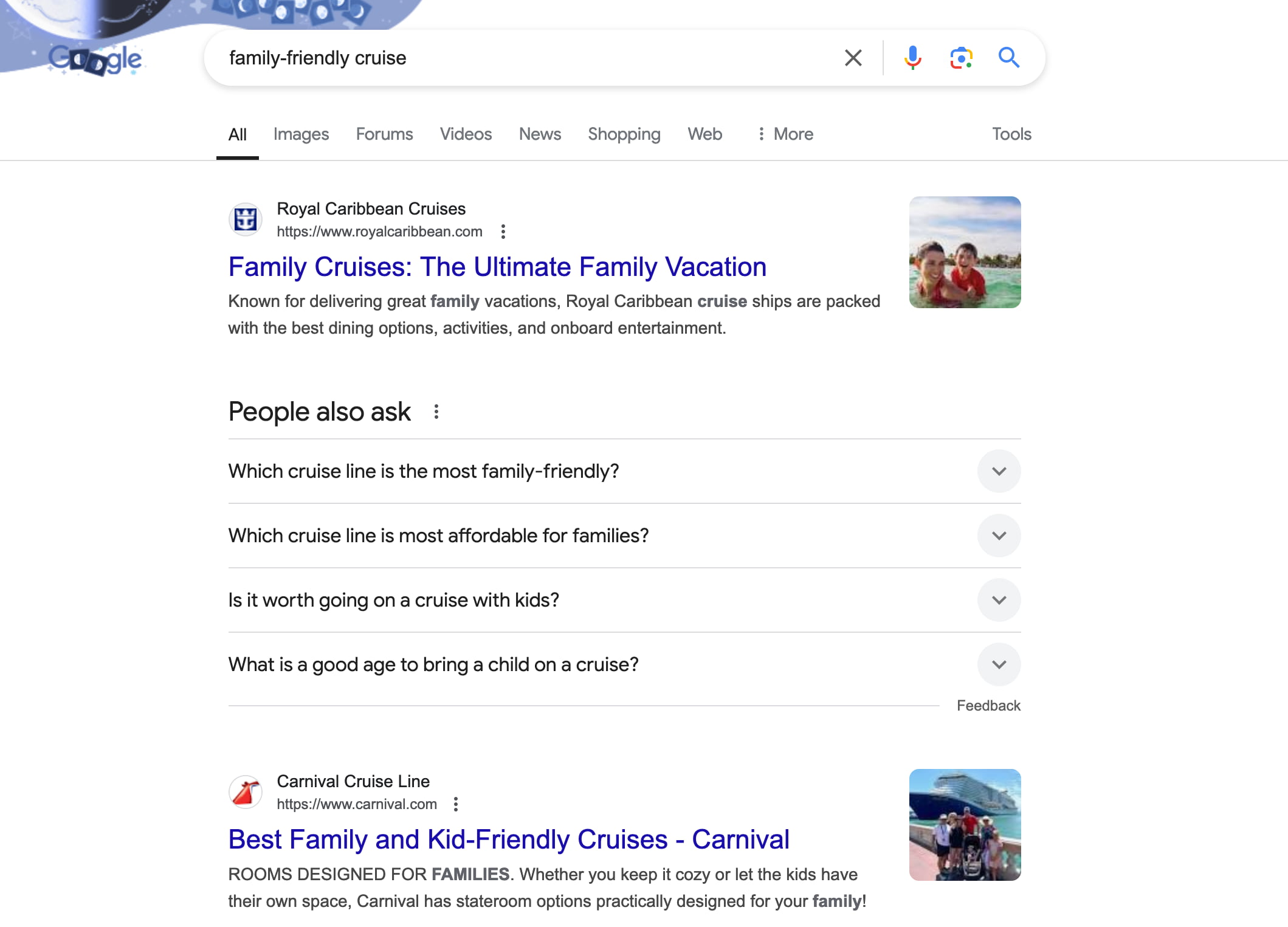
- Take a closer look at the search intent for each keyword
Today’s SEO strategies should, for the most part, revolve around answering the questions people have or providing the best solution for their “problem”. Whenever someone enters a search query into a search engine, they are on a quest for something. Every type of question needs a specific answer.
Learn about search intent
Try to find out which intent your audience has when they type a certain keyphrase into Google. Do they have an informational intent (try to find information on a specific topic), navigational intent (want to access a specific website), commercial intent (want to research something before buying), or transactional intent (want to buy something right now)?
You can learn more about the search intent of certain queries by looking closely at the type of pages that already rank for that query. Do you mostly see product pages? Or a lot of informational blog posts? Do you see videos? Or is it a mix? These are all hints to what Google assumes the search intent of a certain query is. This post explains how to use the search results to create great content that matches the right intent.
Find out which kinds of intent apply to your keyphrases, and add your findings to your spreadsheet!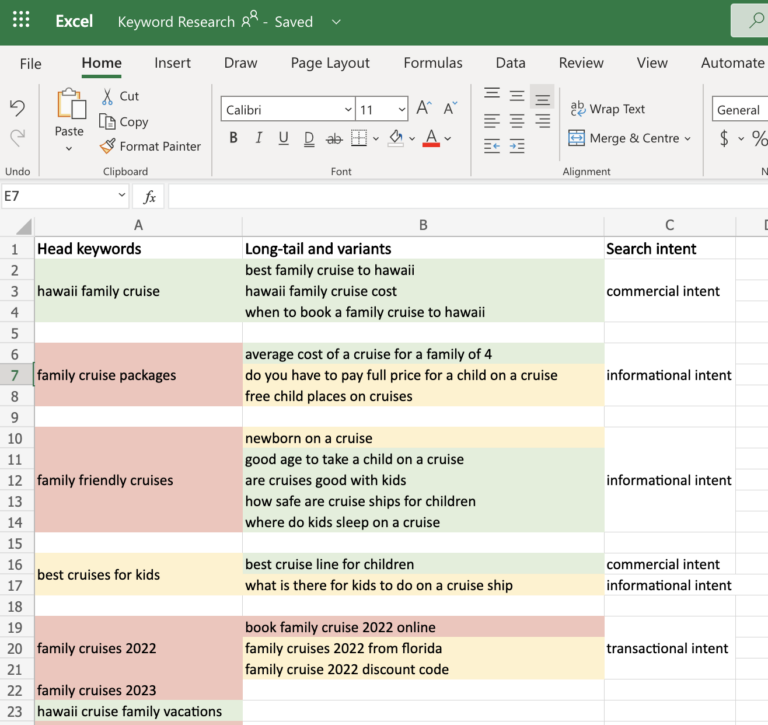
- Determine a keyword strategy – which keywords will you target?
You can determine a keyword strategy based on the data you’ve collected. If you’ve followed the steps above, you should have a spreadsheet with a substantial amount of keyphrases, plus information about the competition and your audience’s search intent for those keyphrases.
Now think about this question: How does my website hold up compared to the websites in the SERPs? Are you of equal size and marketing budget? Then go ahead and focus on those head terms. If not, try using more long-tail keywords first. Focusing on many long-tail keywords combined could attract a lot of traffic. Once you’ve managed to rank for those long-tail keywords, aiming for more head terms will become easier.
When you’ve decided where to jump in, think about the type of content: What was the search intent for my keyphrases? What is my audience looking for? But also, which content can I create that isn’t there yet, and how can I stand out regarding quality or providing solutions? This will help you decide on the type of content you’re going to create. - Create optimized landing pages for your keywords
In theory, this step is out of the scope of keyword research itself. Nevertheless, creating awesome landing pages is essential to get traffic to your website. So, you’ll need to build optimized landing pages for your search terms. You don’t have to create all these pages immediately – it can be long-term. Your keyword strategy will help you prioritize.
Cornerstone content
For your most important keyphrases, you’ll create cornerstone content articles; articles that provide the best possible content about that keyword – authoritative and all-encompassing. All your supporting long-tail articles should link to your cornerstone content pages. This is part of your internal linking strategy, which Yoast SEO Premium can help you implement. You can also use our SEO workout: the Cornerstone content approach to build a strong internal linking strategy in a few easy steps. - Evaluate if your keyword strategy is working and keep improving
Once you’ve thoroughly analyzed your chances to rank on each specific term, published some amazing articles (and optimized them accordingly), you should wait a little. Check out your rankings. Does your article pop up? Did it hit the first page of Google’s SERPs? Or is it hidden away on page two or three? Make sure to evaluate your results in the SERPs.
There are various ways to check how your content performs in the search results. The simplest way is to Google the terms you’ve optimized your articles. Another option is to use Google Search Console to determine which queries you rank for. While the Google Search Console method is a bit more complicated, it can be a great way to find new opportunities! Finally, a third method is to use a keyword tracking tool to monitor your rankings; you can do this easily using the integrated Wincher features in the Yoast SEO plugin.
However you do it, it’s always a good idea to check if your efforts are paying off. If you cannot rank on the first page, try to write another article focused on an (even) more long-tail keyword. Make it a little bit more specific, more niche. And see how that goes. Evaluate again. Continue this process until you hit that first page of the SERPs! - Refresh your keyword research and your content regularly
As time goes on, things will change. Your audience may use different words to search for what they want, so you might need to add new keywords to your sheet. And with the rise of generative AI, the competitive landscape is bound to change, making it easier or harder to target particular keywords. Who knows? Blogging might not be relevant anymore.
A lot can change from year to year, so it’s important to reevaluate and refresh your keyword research periodically. Take the time to update your sheet with the latest information. And don’t forget to keep your content fresh and up-to-date, too!
Quick keyword research
In an ideal world, you would do your keyword research, make a beautiful spreadsheet, and create landing pages for each. Your site structure would be flawless, and you’d blog and write daily, making your site rank higher and higher in Google. But we live in the real world.
Of course, your keyword research will not always be as extensive. And some posts or articles aren’t written as part of an awesome strategy but just because the topic was in the news or something inspired you to write it. That’s just how these things work. But this doesn’t have to be a problem.
If you’re writing something that doesn’t exactly fit your strategy, this doesn’t mean you shouldn’t try to make that content rank. You could still use it to rank for something related to the terms in the list of your keyword strategy. Use the tools mentioned in step 3 and Google Trends to quickly check which keyword you’d like to rank for. At least, take some time to think about how to make your article or blog fit your strategy. After all, if you are writing valuable content, you might as well make it rank! You can find more tips on keyword research on the fly in our focus keyword article.
Practical tips for keyword research
This might sound pretty straightforward, but we know it’s a lot of work and easier said than done. When put into practice, you might encounter some common issues or questions. Here are some tips to make it work!
Prioritize your keyword list
How many keywords should you target? We can’t tell you the exact number of keywords you should have, but we can tell you that you need as many of them as you can think of. However, more than 1000 keywords are probably too many! Even if you’re a reasonably small business, you’ll probably end up with several hundred keywords.
But there’s no need to create pages for all these immediately. You can add content bit by bit. Think about which keywords you want to rank for now (perhaps the more long-tail ones?) and which ones aren’t as important immediately. Understand your priorities and plan the creation of your content.
Read more: Managing a growing blog: content planning »
A focus keyphrase and its synonyms only need one page
In the past, each keyword you wanted to be found for got its landing page. Today, however, search engines are so smart that they mostly use search intent to give searchers the best answer to their questions. The page that answers those questions will rank at the top. Search engines also understand subtle differences between keywords, so you don’t have to create landing pages for every subtle keyword variation, like synonyms.
That doesn’t mean you shouldn’t use synonyms! Synonyms can improve the readability of your copy, so make sure to use them. Our Yoast SEO Premium plugin can help you with this; it allows you to optimize your content for synonyms and related keyphrases. You can fill in the synonyms of your keyphrase under the SEO analysis tab in your Yoast SEO sidebar. You can separate them by commas if you want to fill in more than one. When adding related keyphrases to your text, we have an awesome feature you will want to know more about. So let’s discuss that next!
Add related keyphrases to help Google understand your text
Related keyphrases are words and concepts that deepen and broaden the understanding of your focus keyphrase. They even help Google better understand the topic you’re talking about. Using related keyphrases in your text can paint a complete picture of your focus keyphrase in the article you’re writing.
How do you find related keyphrases?
You might be able to think of a few related keyphrases, but we think using proper keyword data is the safest bet. That’s why we have a Semrush integration in Yoast SEO. It suggests related keyphrases and even shows you the search volume and trend for every keyphrase. As Semrush is one of the world’s leading SEO and marketing software companies, this will help you find the right related keyphrases for your content.
You can find this feature in the Yoast SEO sidebar and meta box. Simply go to the ‘Get related keyphrases’ button underneath the ‘Focus keyphrase’ field and click it. The first time you click this, you must connect your Semrush account or create an account and authorize Yoast SEO to use it. After you’ve connected your account, you will be able to click the ‘Get related keyphrases’ button and find related keyphrases right away:
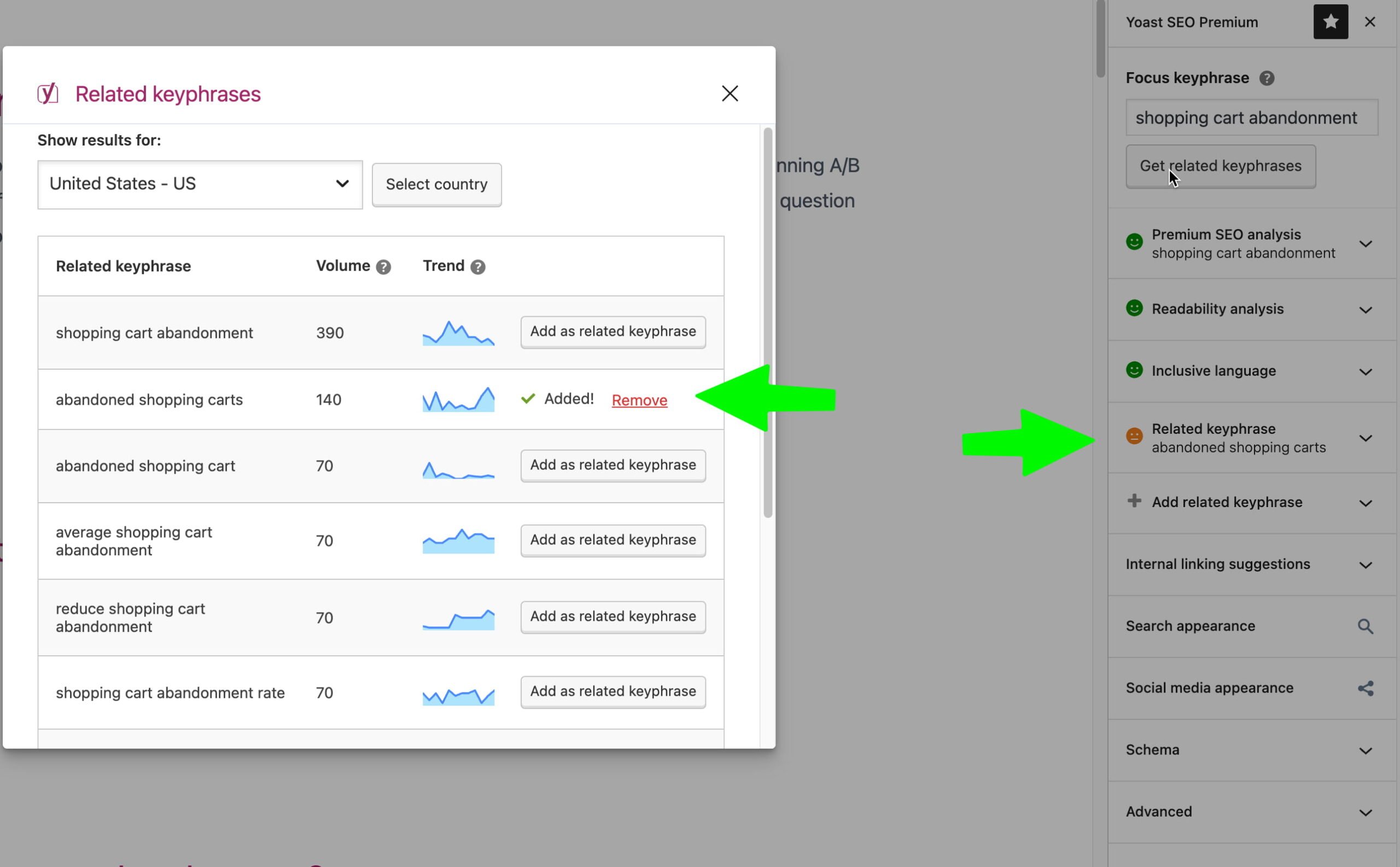
The related keyphrase feature is available for free, but if you use Premium you can also use those related keyphrases to optimize your content with the related keyphrase feature. This feature allows you to add related keyphrases or synonyms to a Yoast SEO sidebar or meta box field. You can easily optimize your content for multiple keyphrases and synonyms. If you want to know more about this integration, we have an article on using the Semrush related keyphrase feature.
Check out results for singular and plural keywords
Should you aim for the singular or the plural keyword? Well, this depends on the query. As Google learns more about the search intent of your query, it can better guess what you’re looking for. For instance, if you search for book, you get different results than if you search for books. Google thinks that in the first case, you’re looking for a definition; in the second case, it believes you intend to buy a book. So make sure you know what you offer on your page and that it fits with the query and results Google gives on that query.
Yoast SEO Premium has word form support, automatically detecting all the different forms of your focus keyphrase (known as keyword stemming). So, you no longer have to optimize your post for a specific word form. Optimizing your post has become a much more natural process. However, there are reasons why you’d still want to optimize for a very specific word form of a keyword. In this case, you can put your focus keyphrase in quotes: “best books ever”. Yoast SEO will now only consider that exact focus keyphrase when checking your content.
Use a keyphrase only once
Beware: You shouldn’t use your exact focus keyword more than once. If you do, your rankings might suffer from keyword cannibalization. Google has a hard time distinguishing between content that’s very alike. Therefore, it might rank very similar posts or pages lower.
Not sure if you used a focus keyphrase before? The post why and how to export your focus keyphrases with Yoast SEO Premium will help you get an overview of the focus keyphrases you’ve used before and on what page. Also, Yoast SEO gives you a warning in the SEO analysis if you use one twice.
Did you know you’ve already used the same or similar keywords or keyphrases on various posts and pages? Then, it probably makes sense to do an SEO audit of your content and merge/delete/redirect some of it. Here’s a step-by-step guide on how to solve keyword cannibalization issues.
Keyword research for ecommerce SEO
In ecommerce SEO, aim for keywords that potential buyers use during their purchasing journey. Focus on transactional terms linked to specific products, features, or brand names. Consider seasonal fluctuations in search behavior and monitor competitors to discover effective keywords that drive traffic in your niche. Long-tail keywords, while less competitive, can attract highly motivated buyers closer to purchasing. For further insights, read our guide to keyword research for online stores.
How to do keyword research for YouTube
YouTube SEO requires a distinct approach, focusing on informational keywords that users search for on the platform. Use tools like TubeBuddy to identify high-volume search terms that often feature in video search results. Align your content strategy with YouTube’s unique search patterns by analyzing YouTube Analytics for insights into current trends and user interests. By doing so, you can create engaging content that draws more viewers and retains their attention. For a detailed guide on how to do this, check out our article on YouTube keyword research.
Ready? Start writing!
Keyword research should be the start of any sustainable SEO strategy. The result will be a long list of keywords for which you’d like to be found. But the hardest part is still ahead: writing all that content. You should write articles and blog posts on every keyword you want to be found for. That’s quite a challenge. Check out our ultimate guide to SEO copywriting to get started!
Keep reading: WordPress SEO: The definitive guide to higher rankings for WordPress sites »

